Eastwell Manor will always hold a special place in my heart;
it’s where Steve and I got married. Returning to it always feels a little like coming home – in fact
(unabashed bragging here) my family does have ancestral ties to the Manor, a
fact we discovered only after we had booked the place for the wedding. Unfortunately they aren’t strong enough to
boot the current owners out and take up a permanent residency.
Eastwell really is the quintessential country park and
estate, originally built over the course of 10 years between 1540 and 1550 as a
private residence for Sir Thomas Moyle.
Nowadays the Manor serves as a country house hotel, complete with golf
and fishing facilities and the land also operates as a working farm.
To me, it is just beautiful.
Situated in the village of Boughton Lees, between Canterbury and Ashford, you enter through the
great gates and drive up the sweeping track, past the fields of sheep until you
reach the Manor proper. There, you pull
in across crunching gravel and cross the courtyard lit by the yellow gleam of
the Manor’s windows. As you are walking,
the scent of wood smoke hits you immediately from the great fire in the
entrance hall. It feels like you are stepping back in time.
Upon entering, we were led into the bar area where our table
had been set up in the bay window. This bar has some seriously impressive spirits and liquors behind it. When my grandfather offered to buy Steve a drink on our wedding day, he was very, very tempted to opt for the Napoleonic brandy that was encased in a locked, glass cabinet. It's lucky he didn't - I think it was about £500 a measure! We weren't interested in the bar though, and instead sank into deep sofa’s, glanced at the menu options, and all four of us ordered
the Champagne Tea at a very reasonable £29 a head. Champagne for myself,
Kir Royale for Claire and Ellie and a Bellini for Jo.
The afternoon tea at Eastwell is seasonal, with the flavours and ingredients being selected to complement the time of the year. We were treated to sandwiches
filled with roast beef and rocket, crayfish and smoked salmon, cream cheese and
cucumber and egg mayonnaise. The scones
were fresh baked, some filled with dried fruits, and served with clotted cream,
spiced fruit jam and, much to Jo’s delight as it is one of her most favourite things
in the world, lemon curd.
The cake and pastries were the crowning glory though. Each one invoked the soul of autumn in every
flavourful morsel. There was sticky
maple and pecan tartlets, spiced apple trifle with walnuts and brandy soaked
pieces of lady finger, moist chocolate brownies and pumpkin cake topped with cinnamon
cream.
I was chatting with The Demon Gin a few days after this, comparing notes on afternoon tea, and she noted that her fella had commented that, for the price of an average afternoon tea, he could get an enormous steak, pile of chips and a few beers. Well, yes, I'm not going to argue with that, but afternoon tea is more than just the pots of tea and scones. It's the entire experience - being in luxurious surroundings, waited on hand and foot, spending time with your nearest and dearest and, for a few hours at least, escaping from the real world. Eastwell manages to carry this off with finesse.
The tea menu is extensive. I opted for the Eastwell blend, a mixture of
Assam and Ceylon teas that was perfect for me.
Ellie, being the only non-tea drinker with us, had an entire teapot of
hot chocolate prepared for her at no extra charge. The solid silver milk jugs added a touch of luxury to the meal. They were seriously heavy!
Afternoon tea never looks as though it will be enough to
sate your appetite, but we had to be rolled out when we had finished, and there
were still a couple of items left uneaten.
We had been there for a good few hours and had been left to enjoy
ourselves, the tea and the surroundings in peace by the staff, only occasionally
being interrupted to see if there was anything else we required.
Post tea, we went for a stroll around the gardens, partly to
walk off some of our excesses, partly to enjoy the surroundings. It is from the gardens that the most
impressive views of Eastwell can be enjoyed.
I didn’t know the girls when I got married, so I showed them the Italian
garden where our ceremony took place. It looked a bit forlorn in the early evening light; the last time I was there the place had been bursting with flowers and blooms in every colour imaginable. The views back over the down's are still as impressive as ever though.
The grounds really are beautiful, wide avenues flanked by meticulously trimmed hedges leading onto sweeping lawns and the great fountain presiding over it all quietly in the centre.
Given the choice, I would happily stay here forever.
If you like (or hate!) what you have read, please do let me know in the comments below or slap me with a cheeky follow, or say Hi to me on my facebook group or twitter!

















































